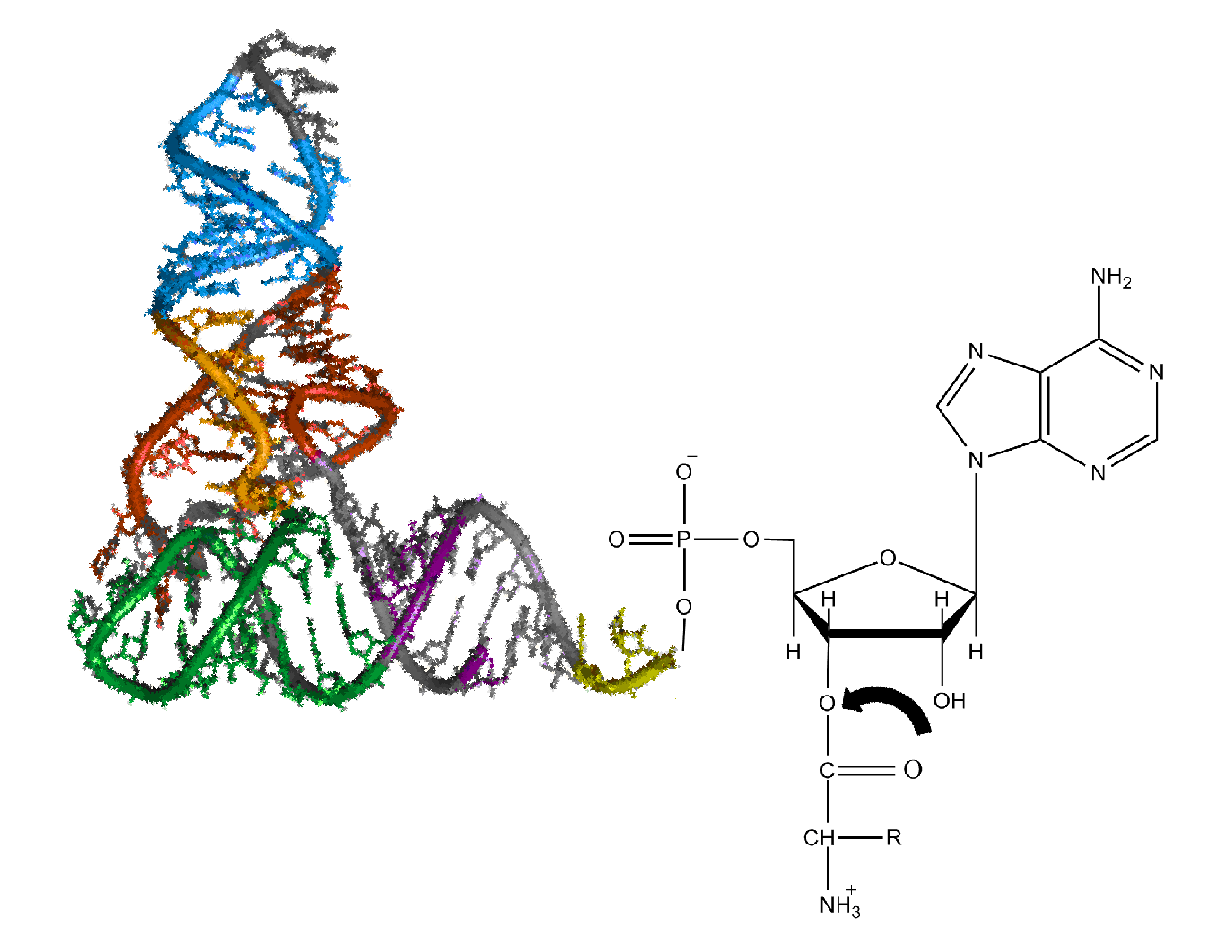|
Bacterial Initiation Factor 1
Bacterial initiation factor 1 is a bacterial initiation factor. IF1 associates with the 30S ribosomal subunit in the A site and prevents an aminoacyl-tRNA from entering. It modulates IF2 binding to the ribosome by increasing its affinity. It may also prevent the 50S 50 S is the larger subunit of the 70S ribosome of prokaryotes, i.e. bacteria and archaea. It is the site of inhibition for antibiotics such as macrolides, chloramphenicol, clindamycin, and the pleuromutilins. It includes the 5S ribosom ... subunit from binding, stopping the formation of the 70S subunit. It also contains a β-domain fold common for nucleic acid binding proteins. IF1– IF3 may also perform ribosome recycling. References {{GeneticTranslation Protein biosynthesis Gene expression ... [...More Info...] [...Related Items...] OR: [Wikipedia] [Google] [Baidu] |
Bacterial Initiation Factor
A bacterial initiation factor (IF) is a protein that stabilizes the initiation complex for polypeptide translation. Translation initiation is essential to protein synthesis and regulates mRNA translation fidelity and efficiency in bacteria. The 30S ribosomal subunit, initiator tRNA, and mRNA form an initiation complex for elongation. This complex process requires three essential protein factors in bacteria – IF1, IF2, and IF3. These factors bind to the 30S subunit and promote correct initiation codon selection on the mRNA. IF1, the smallest factor at 8.2 kDa, blocks elongator tRNA binding at the A-site. IF2 is the major component that transports initiator tRNA to the P-site. IF3 checks P-site codon-anticodon pairing and rejects incorrect initiation complexes. The orderly mechanism of initiation starts with IF3 attaching to the 30S subunit and changing its shape. IF1 joins next, followed by mRNA binding, and starts codon-P-site interaction. IF2 enters with the initiator tRNA and p ... [...More Info...] [...Related Items...] OR: [Wikipedia] [Google] [Baidu] |
A Site
Ribosomes () are macromolecular machines, found within all cells, that perform biological protein synthesis (messenger RNA translation). Ribosomes link amino acids together in the order specified by the codons of messenger RNA molecules to form polypeptide chains. Ribosomes consist of two major components: the small and large ribosomal subunits. Each subunit consists of one or more ribosomal RNA molecules and many ribosomal proteins (). The ribosomes and associated molecules are also known as the ''translational apparatus''. Overview The sequence of DNA that encodes the sequence of the amino acids in a protein is transcribed into a messenger RNA (mRNA) chain. Ribosomes bind to the messenger RNA molecules and use the RNA's sequence of nucleotides to determine the sequence of amino acids needed to generate a protein. Amino acids are selected and carried to the ribosome by transfer RNA (tRNA) molecules, which enter the ribosome and bind to the messenger RNA chain via an anticodon ... [...More Info...] [...Related Items...] OR: [Wikipedia] [Google] [Baidu] |
Aminoacyl-tRNA
Aminoacyl-tRNA (also aa-tRNA or charged tRNA) is tRNA to which its cognate amino acid is chemically bonded (charged). The aa-tRNA, along with particular elongation factors, deliver the amino acid to the ribosome for incorporation into the polypeptide chain that is being produced during translation. Alone, an amino acid is not the substrate necessary to allow for the formation of peptide bonds within a growing polypeptide chain. Instead, amino acids must be "charged" or aminoacylated with a tRNA to form their respective aa-tRNA. Every amino acid has its own specific aminoacyl-tRNA synthetase, which is utilized to chemically bind to the tRNA that it is specific to, or in other words, "cognate" to. The pairing of a tRNA with its cognate amino acid is crucial, as it ensures that only the particular amino acid matching the anticodon of the tRNA, and in turn matching the codon of the mRNA, is used during protein synthesis. In order to prevent translational errors, in which the wrong ... [...More Info...] [...Related Items...] OR: [Wikipedia] [Google] [Baidu] |
Prokaryotic Initiation Factor-3
In molecular biology, translation initiation factor IF-3 (gene infC) is one of the three factors required for the initiation of protein biosynthesis in bacteria. IF-3 is thought to function as a fidelity factor during the assembly of the ternary initiation complex which consists of the 30S ribosomal subunit, the initiator tRNA and the messenger RNA. IF-3 is a basic protein that binds to the 30S ribosomal subunit. The chloroplast homolog enhances the poly( A, U, G)-dependent binding of the initiator tRNA to its ribosomal 30s subunits. IF1–IF3 may also perform ribosome recycling. IF3 is not universally found in all bacterial species. However, in ''E. coli'', it is required for the 30S subunit to bind to the initiation site in mRNA. In addition, it has several other jobs including the stabilization of free 30S subunits, enables 30S subunits to bind to mRNA and checks for accuracy against the first aminoacyl-tRNA. It also allows for rapid codon-anticodon pairing for the initiato ... [...More Info...] [...Related Items...] OR: [Wikipedia] [Google] [Baidu] |
Protein Biosynthesis
Protein biosynthesis, or protein synthesis, is a core biological process, occurring inside Cell (biology), cells, homeostasis, balancing the loss of cellular proteins (via Proteolysis, degradation or Protein targeting, export) through the production of new proteins. Proteins perform a number of critical functions as enzymes, structural proteins or hormones. Protein synthesis is a very similar process for both prokaryotes and eukaryotes but there are some distinct differences. Protein synthesis can be divided broadly into two phases: Transcription (biology), transcription and Translation (biology), translation. During transcription, a section of DNA encoding a protein, known as a gene, is converted into a molecule called messenger RNA (mRNA). This conversion is carried out by enzymes, known as RNA polymerases, in the cell nucleus, nucleus of the cell. In eukaryotes, this mRNA is initially produced in a premature form (Primary transcript, pre-mRNA) which undergoes post-transcriptio ... [...More Info...] [...Related Items...] OR: [Wikipedia] [Google] [Baidu] |

